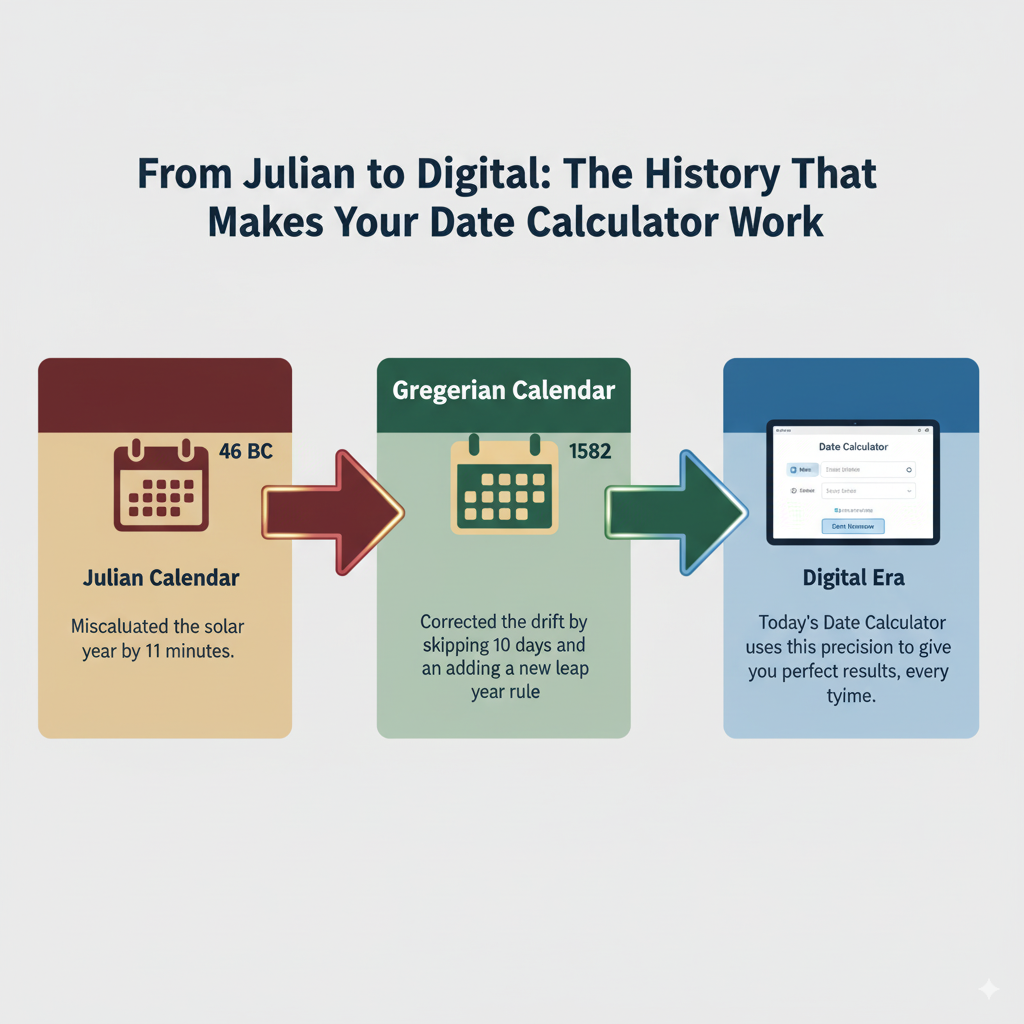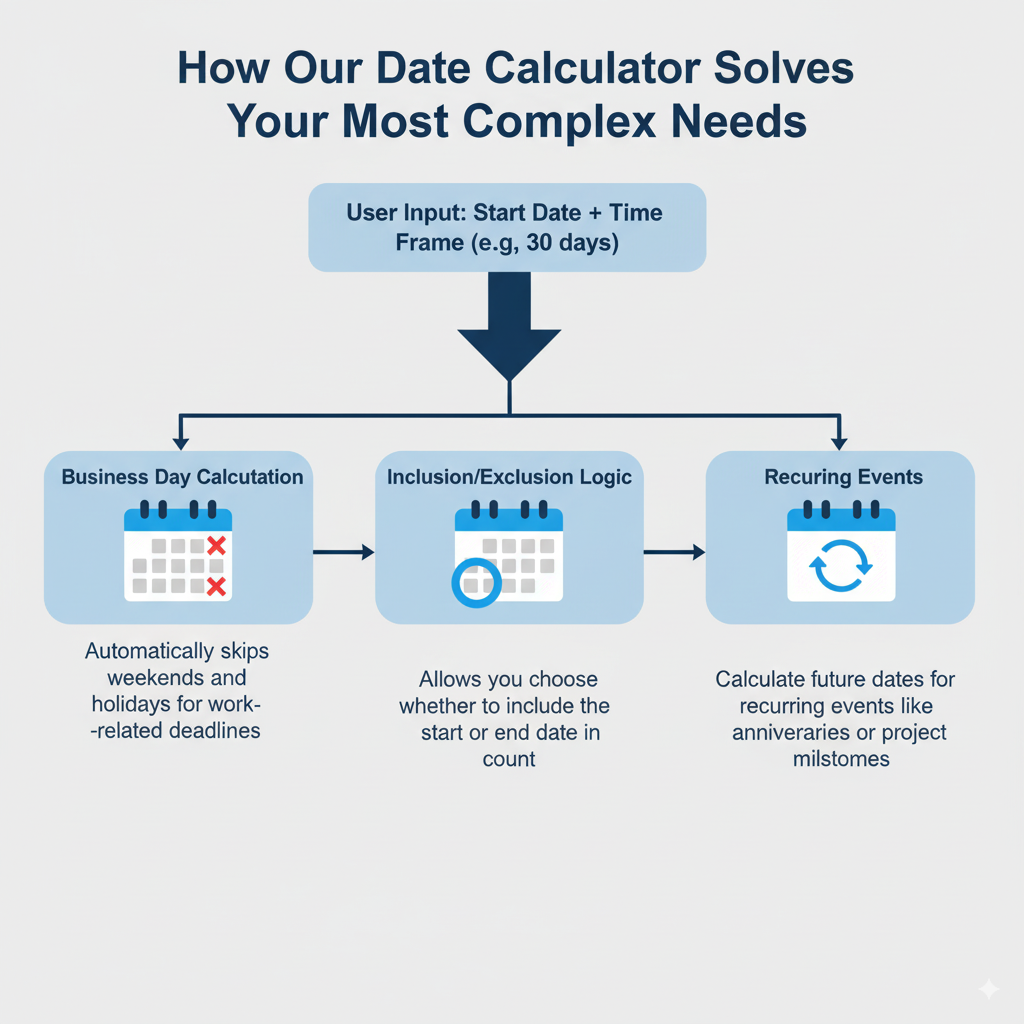Date Calculator
Calculate the difference between two dates, including business days and UK public holidays.
Explore other calculators
You can check our other calculators to calculate different things.
Add to or Subtract from a Date
The Ultimate Guide to Using a Date Calculator
A date calculator is a digital tool that allows you to calculate days between dates, add or subtract days from a specific date, and determine future or past deadlines instantly. This tool is widely used for project scheduling, vacation planning, wedding countdowns, pregnancy due date tracking, and even as an age calculator by date of birth. With features like a days between dates calculator and an add days to date calculator, it provides accurate results for both personal and professional planning. By eliminating manual counting errors, a date calculator saves time, ensures precision, and keeps life organised.
What is a Date Calculator?
A date calculator is an online tool that allows users to add or subtract days, weeks, months, or even years from a specific date. It simplifies what can sometimes be a tedious task – manually counting days on a calendar – and minimises the chances of human error.
This tool is widely used in accounting, finance, legal documentation, and healthcare for various applications, such as determining payment deadlines, calculating maturity dates, and predicting due dates based on ovulation.
It also supports users in managing holiday schedules, project timelines, and other day-to-day life scenarios.
Why You Should Use a Date Calculator
The importance of a date calculator lies in its precision, speed, and user-friendliness. Here’s why it’s a must-have tool:
Efficiency: Easily determine the number of days between two dates.
Accuracy: Eliminate manual errors that could occur while calculating dates.
Convenience: Save time in both personal and professional planning.
Versatility: Applicable for business, healthcare, education, and more.
Let’s explore the origins of the calendar we use today and understand how a date calculator ties into this historic development.
A Brief History of the Gregorian Calendar

Today, we use the Gregorian calendar, which was introduced in 1582 by Pope Gregory XIII as a correction to the Julian calendar. The Julian system, initiated by Julius Caesar, included a leap year every four years. However, it miscalculated the length of a solar year by 11 minutes, causing a gradual drift over centuries.
The Gregorian reform corrected this by skipping 10 days and implementing a more accurate leap year rule. Under this system, a year is considered a leap year only if it’s divisible by 4, but century years must also be divisible by 400. This change reduced the drift to just one day every 3,030 years.
Thanks to this alignment with the solar year, a date calculator can now work more accurately across centuries without discrepancies.
How a Date Calculator Works
Using a date calculator is straightforward. Users input a start date and specify the time to add or subtract—be it days, weeks, months, or years. The tool then calculates and returns the resulting date. Some calculators also allow reverse calculation: providing an end date and figuring out the duration between two points in time.
Additionally, advanced calculators provide features for:
Skipping weekends or specific holidays.
Including or excluding start and end dates.
Setting recurring events.
This functionality makes a date calculator invaluable in professional environments where precision and planning are critical.

Types of Date Calculators
Basic Date Calculators: These handle simple additions and subtractions of days.
Business Day Calculators: These exclude weekends and holidays.
Pregnancy or Fertility Calculators: Tools like a fertilisation date calculator, conceived date to calculate due date, or due date calculator based on ovulation help track key reproductive milestones.
Event Planners: These are tailored to planning birthdays, anniversaries, or corporate events.
Using a Date Calculator for Financial Planning
In accounting and finance, deadlines are everything. Whether you’re calculating the due date for an invoice or the maturity of an investment, a date calculator ensures compliance and timeliness. You can quickly determine:
Tax return deadlines
Interest accrual periods
Loan repayment schedules
Such uses are especially critical in high-stakes environments like payroll departments or financial institutions.
Healthcare and Pregnancy: Specialised Use Cases
In healthcare, particularly in gynecology and obstetrics, date calculators are widely used. Tools like the fertilisation date calculator help predict ovulation windows and estimate the most fertile days. Meanwhile, tools such as conceived date to calculate due date and due date calculator based on ovulation provide expecting mothers and healthcare professionals with accurate predictions for delivery timelines.
These tools are typically used in tandem with other methods like ultrasound data to provide better clarity and support prenatal care planning.
How to Calculate Next Period Date
For those tracking their menstrual cycles, knowing how to calculate next period date is essential for both fertility planning and general wellness. Using a date calculator, one can input the start date of their last period and the average cycle length to estimate the next expected period.
This method allows users to prepare in advance, manage appointments, and understand bodily rhythms with more confidence.
Managing Holidays and Work Schedules
Understanding when public holidays occur is vital for workforce management. Our date calculator comes pre-loaded with UK National holidays and even allows for custom holiday entries for other countries or specific regions.
Here are some examples:
Holidays and Observances in the United Kingdom in 2025
| Date | Name | Type | ||
|---|---|---|---|---|
| 1 Jan | Wednesday | New Year’s Day | Bank Holiday | |
| 5 Jan | Sunday | Twelfth Night | Observance, Christian | |
| 14 Feb | Friday | Valentine’s Day | Observance | |
| 4 Mar | Tuesday | Carnival / Shrove Tuesday / Pancake Day | Observance, Christian | |
| 30 Mar | Sunday | Mother’s Day | Observance | |
| 18 Apr | Friday | Good Friday | Bank Holiday | |
| 20 Apr | Sunday | Easter Sunday | Observance, Christian | |
| 5 May | Monday | Early May Bank Holiday | Bank Holiday | |
| 26 May | Monday | Spring Bank Holiday | Bank Holiday | |
| 14 Jun | Saturday | King’s Birthday | Observance | |
| 15 Jun | Sunday | Father’s Day | Observance | |
| 31 Oct | Friday | Halloween | Observance | |
| 5 Nov | Wednesday | Guy Fawkes Day | Observance | |
| 9 Nov | Sunday | Remembrance Sunday | Observance | |
| 24 Dec | Wednesday | Christmas Eve | Observance, Christian | |
| 25 Dec | Thursday | Christmas Day | Bank Holiday | |
| 26 Dec | Friday | Boxing Day | Bank Holiday | |
| 31 Dec | Wednesday | New Year’s Eve | Observance |
Holidays and Observances in the United Kingdom in 2026
| Date | Name | Type | ||
|---|---|---|---|---|
| 1 Jan | Thursday | New Year’s Day | Bank Holiday | |
| 5 Jan | Monday | Twelfth Night | Observance, Christian | |
| 14 Feb | Saturday | Valentine’s Day | Observance | |
| 17 Feb | Tuesday | Carnival / Shrove Tuesday / Pancake Day | Observance, Christian | |
| 15 Mar | Sunday | Mother’s Day | Observance | |
| 3 Apr | Friday | Good Friday | Bank Holiday | |
| 5 Apr | Sunday | Easter Sunday | Observance, Christian | |
| 4 May | Monday | Early May Bank Holiday | Bank Holiday | |
| 25 May | Monday | Spring Bank Holiday | Bank Holiday | |
| 20 Jun | Saturday | King’s Birthday | Observance | |
| 21 Jun | Sunday | Father’s Day | Observance | |
| 31 Oct | Saturday | Halloween | Observance | |
| 5 Nov | Thursday | Guy Fawkes Day | Observance | |
| 8 Nov | Sunday | Remembrance Sunday | Observance | |
| 24 Dec | Thursday | Christmas Eve | Observance, Christian | |
| 25 Dec | Friday | Christmas Day | Bank Holiday | |
| 26 Dec | Saturday | Boxing Day | Bank Holiday | |
| 28 Dec | Monday | Substitute Bank Holiday for Boxing Day | Bank Holiday | |
| 31 Dec | Thursday | New Year’s Eve | Observance |
Benefits of Using a Date Calculator in Everyday Life

Beyond finance and health, a date calculator finds its utility in various walks of life:
Education: Helps students and teachers schedule assignments and exams.
Travel Planning: Ensures accurate duration estimates for visas and bookings.
Project Management: Aids in setting realistic timelines for task completion.
Event Management: Schedules important life events like weddings and reunions without conflict.
How to Make the Most of Your Date Calculator
To leverage the full potential of this tool:
Always double-check time zones when planning international events.
Use holiday exclusion settings for business-related tasks.
Combine it with reminders to stay on top of deadlines.
Most importantly, understand the context of your calculation. Whether you’re estimating your due date based on ovulation, finding your next period date, or tracking a loan repayment schedule, being aware of external factors (like holidays or work schedules) enhances the tool’s effectiveness.
Final Thoughts
A date calculator is more than just a calendar add-on, it’s a strategic tool that helps streamline both personal and professional planning. From tracking deadlines and managing projects to calculating pregnancy dates and holidays, this tool offers precision and clarity in an increasingly complex world.
Whether you’re using it as a dates calculater for daily tasks or leveraging its advanced features like the fertilisation date calculator, conceived date to calculate due date, or figuring out how to calculate next period date, you’ll find it indispensable.
In summary, a date calculator serves as an essential part of planning and decision-making. No matter your profession or lifestyle, integrating this simple tool into your daily routine can help bring structure, accuracy, and peace of mind to your schedule.
Start using our date calculator today and experience the power of efficient planning at your fingertips.
